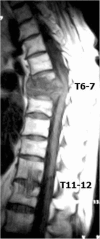Evaluation and Management of Pyogenic and Tubercular Spine Infections
- PMID: 30280287
- PMCID: PMC6220010
- DOI: 10.1007/s12178-018-9523-y
Evaluation and Management of Pyogenic and Tubercular Spine Infections
Abstract
Purpose of review: To review the most current diagnostic tools and treatment options for pyogenic and tubercular spine infection.
Recent findings: Recent studies have focused on risk factors for failed nonoperative management in order to improve patient selection. Also, spine instrumentation and different grafting options have been safely utilized in the setting of an active infection without increasing the incidence of reoccurrence. However, the optimal surgical technique has yet to be established and instead should be patient specific. Spine infections include a broad spectrum of disorders including discitis, vertebral osteomyelitis, and spinal epidural abscess. It is paramount to recognized spine infections early due to the potential catastrophic consequences of paralysis and sepsis. The management of spine infections continues to evolve as newer diagnostic tools and surgical techniques become available. Magnetic resonance imaging with contrast is the imaging study of choice and computed tomography-guided biopsies are crucial for guiding antibiotic selection. Antibiotics are the mainstay of treatment and surgery is indicated in patients with neurological deficits, sepsis, spinal instability, and those who have failed nonoperative treatment.
Keywords: Epidural abscess; Spine infection; Spondylodiscitis; Tuberculosis; Vertebral osteomyelitis.
Conflict of interest statement
Conflict of Interest
Dr. Boody reports personal fees from Innovative Surgical Designs, outside the submitted work. The other authors declare no conflicts of interest.
Human and Animal Rights and Informed Consent
This article does not contain any studies with human or animal subjects performed by any of the authors.
Figures




References
-
- Berbari EF, Kanj SS, Kowalski TJ, Darouiche RO, Widmer AF, Schmitt SK, et al. Executive Summary: 2015 Infectious Diseases Society of America (IDSA) Clinical practice guidelines for the diagnosis and treatment of native vertebral osteomyelitis in adults: Table 1. Clin Infect Dis. 2015;61(6):859–863. doi: 10.1093/cid/civ633. - DOI - PubMed
Publication types
LinkOut - more resources
Full Text Sources
Research Materials

